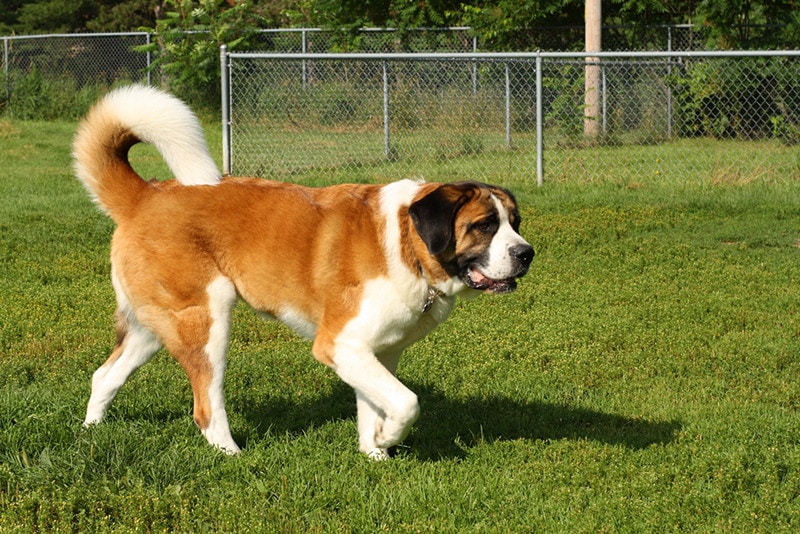Click to Skip Ahead
Saint Bernards are a popular dog breed that’s recognized by most people. While they have a charming and noble appearance and are well-known for their gentle temperaments, they’re not going to be a good fit for everyone.
Having realistic expectations of what daily life with a Saint Bernard looks like can help you determine if this dog breed will fit in well with your lifestyle. Here are some pros and cons you’ll want to weigh if you’re considering bringing home a Saint Bernard.
Saint Bernard Pros
1. Easygoing and Laid Back Temperaments
Saint Bernards have charming personalities. Despite their large size, they’re known to be laidback and friendly. While they aren’t extroverted social butterflies, they also don’t have very strong guarding instincts. So, it may take them a little time to warm up to strangers, but they don’t mind having new people enter their homes and are open to making new friends.
Because of their easygoing temperaments, they can be good fits for people with different kinds of lifestyles. They can be your outdoor companions, and they’re also content with spending a lazy Saturday on the couch with you.

2. Good With Children
Saint Bernards are highly loyal and loving with their families. They’re known to be gentle and patient with children and often become doting and protective companions. Just keep in mind that proper socialization is required for both dogs and children. Children must learn to interact with Saint Bernards respectfully, and Saint Bernards may need some help becoming aware of how large they are compared to younger children.
The first few interactions between Saint Bernards and children must be supervised to prevent any accidents. These supervised interactions will help both your Saint Bernard and children not to play too rough with each other.
3. Intelligent and Easy to Train
Saint Bernards are known for their intelligence and intuition, and they relied on these qualities to become successful search and rescue dogs. You may notice your Saint Bernard having a mind of their own in the beginning stages of training. However, as you keep up with consistent obedience training and continue to build a strong bond with your Saint Bernard, you’ll find that training becomes easier.
Your Saint Bernard will also be able to pick up on new commands and tricks relatively quickly. At the end of the day, Saint Bernards are eager to please and respond very well to praise and positive rewards.

4. Don’t Require Extensive Exercise
Although they have origins as search and rescue dogs, Saint Bernards don’t require intensive daily exercise. Moderate exercise usually suffices, and they’ll be content with one long daily walk or a 30-minute play session.
If anything, Saint Bernard owners must be concerned with not overexercising their Saint Bernards. Saint Bernards are prone to hip dysplasia and heat exhaustion. Too much exercise can cause stress on their joints or overheating, especially on a hot day.
5. Don’t Tend to Be Needy
While Saint Bernards develop strong bonds with their families, they don’t tend to be needy. When they consistently receive a healthy amount of mental and physical exercise, they’re perfectly content lounging in the same room as you go about your day. It’s unlikely for a Saint Bernard to constantly want your attention and distract you if you’re working from home. They know how to keep themselves entertained and will be happy to play with a toy on their own while they wait for you to finish working.

Saint Bernard Cons
1. Expensive to Care For
While caring for any dog will take up a significant portion of your budget, caring for Saint Bernards often requires a higher budget. Their large size means that they’ll consume more food and require bigger equipment. Food and supplies for giant dog breeds are generally more expensive than products designed for smaller dogs and toy breeds.
Grooming and medical treatments tend to cost more for large dogs as well. You’ll also probably go through toys more quickly and will have to buy more expensive, heavy-duty toys that can withstand their strong jaws and heavy chewing.
2. Heavy Shedding
Saint Bernards have thick double coats that shed moderately throughout the year. They also have biannual shedding seasons and shed heavily during this time as their coats are preparing for a new season. While you can get by with weekly brushing for most of the year, daily brushing is a must during shedding season. You can also expect to spend more time cleaning and vacuuming to reduce the amount of hair on your clothes and furniture.

3. Prone to Heat Exhaustion
Saint Bernards were bred to survive in the cold Swiss Alps. They have thick double coats that enable them to endure cold and snowy winters. While they can tolerate warmer weather, they’re prone to heat exhaustion and can’t live in climates with extremely hot summers.
Saint Bernard owners must be extra attentive to how their Saint Bernards are doing when they’re outside on a warm day. These dogs shouldn’t overexert themselves and exercise too much, and they must get plenty of rest and time to cool down in between activities.
4. Expect a Lot of Drool
Saint Bernards can be pretty mouthy and are heavy droolers. The drooling can be even more noticeable simply because of their large size. When living with a Saint Bernard, be prepared to wipe up dog drool regularly, and don’t be surprised if your furniture gets slobber and mud tracks on them.
If you do have expensive furniture, it’ll be especially important to invest in training your Saint Bernard not to lay on your furniture. Along with the potential of drooling, your Saint Bernard may accidentally scratch or puncture your furniture with their nails.

5. Requires a Lot of Space
While they may not be high-energy dogs, Saint Bernards still do best living in larger homes with open spaces. Their large size makes them prone to accidentally knocking things off tables and countertops. If they’re not trained properly, they can easily swipe food off your table or reach food placed on higher shelves in your pantry.
Living in a smaller space with a large and high-shedding dog like a Saint Bernard will only make the shedding more noticeable. Loose hair will accumulate much faster, and you’ll likely find loose hair on your clothes, furniture, and even in your food.
Summing Up
While all dogs do well with a strong foundation in obedience training and socialization, there are some core things that you just can’t change about a dog. Saint Bernards are known to be gentle and easy to train, but some things that won’t change about them are their high shedding coats and relatively expensive care costs. So, take plenty of time to weigh the potential pros and cons of living with a Saint Bernard. This will ensure that you end up with a pet that matches your lifestyle and that you can provide a forever home for them.
Featured Image Credit: Nick Chase 68, Shutterstock












